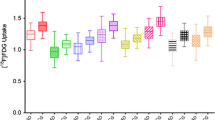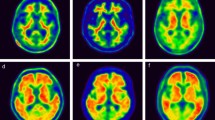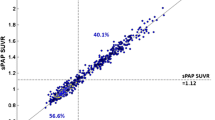Abstract
Purpose
To investigate regional cerebral amyloid beta retention in cognitively normal Korean adults using F-18 florbetaben (FBB).
Methods
We prospectively analyzed F-18 FBB positron emission tomography (PET)/CT scans of 30 cognitively healthy adults (age range, 50–70 years) using automated quantification. The standardized uptake value ratios (SUVRs) of F-18 FBB were calculated for predefined regions by normalizing the regional count with cerebellar cortex.
Results
The distribution of amyloid beta for each brain region revealed no age-related trends (p > 0.05). From all subjects, mean SUVR of amyloid deposit was 1.30 ± 0.18. The right parietal lobe showed the highest SUVR value (1.46 ± 0.23), whereas the right frontal lobe and left precuneus showed the lowest SUVR (1.23 ± 0.25).
Conclusions
We provide reference values of normative data obtained from healthy elderly Koreans and suggest its use for accurate diagnosis of patients with Alzheimer’s disease.


Similar content being viewed by others
References
Jack CR Jr, Knopman DS, Jagust WJ, Petersen RC, Weiner MW, Aisen PS, et al. Tracking pathophysiological processes in Alzheimer’s disease: an updated hypothetical model of dynamic biomarkers. Lancet Neurol. 2013;12:207–16.
Sabri O, Seibyl J, Rowe C, Barthel H. Beta-amyloid imaging with florbetaben. Clin Transl Imaging. 2015;3:13–26.
Landau SM. Optimizing longitudinal amyloid-β PET measurement: the challenges of intensity normalization. J Nucl Med. 2018;59:1581–2.
Tuszynski T, Rullmann M, Luthardt J, Butzke D, Tiepolt S, Gertz H, et al. Evaluation of software tools for automated identification of neuroanatomical structures in quantitative β-amyloid PET imaging to diagnose Alzheimer’s disease. Eur J Nucl Med Mol Imaging. 2016;43:1077–87.
Veronese M, Bodini B, García-Lorenzo D, Battaglini M, Bongarzone S, Comtat C, et al. Quantification of C-11 PIB PET for imaging myelin in the human brain: a test—retest reproducibility study in high-resolution research tomography. J Cereb Blood Flow Metab. 2015;35:1771–82.
Barthel H, Senda M, Luthardt J, Strick A, Yamane T, Patt M, et al. Influence of ethnic group, age, gender, and tracer mass dose on florbetaben β-amyloid brain PET results in elderly normal controls. Alzheimers Dement. 2010;6:S436.
Um YH, Choi WH, Jung WS, Park YH, Lee C, Lim HK. Whole brain voxel-wise analysis of cerebral retention of Beta-amyloid in cognitively normal older adults using 18F-florbetaben. Psychiatry Investig. 2017;14:883.
Alzheimer’s Association. 2018 Alzheimer’s disease facts and figures. Alzheimers Dement. 2018;14:367–429.
Ampil ER, Fook-Chong S, Sodagar SN, Chen CPH, Auchus AP. Ethnic variability in dementia: results from Singapore. Alzheimer Dis Assoc Disord. 2005;19:184–5.
Becker JA, Hedden T, Carmasin J, Maye J, Rentz DM, Putcha D, et al. Amyloid-β associated cortical thinning in clinically normal elderly. Ann Neurol. 2011;69:1032–42.
Presotto L, Laccarino L, Sala A, Vanoli EG, Muscio C, Nigri A, et al. Low-dose CT for the spatial normalization of PET images: a validation procedure for amyloid-PET semi-quantification. NeuroImage Clin. 2018;20:153–60.
Barthel H, Gertz H, Dresel S, Peters O, Bartenstein P, Buerger K, et al. Cerebral amyloid-β PET with florbetaben (18F) in patients with Alzheimer’s disease and healthy controls: a multicentre phase 2 diagnostic study. Lancet Neurol. 2011;10:424–35.
Acknowledgments
The authors are grateful to Dr. Yoon for the assistance with data arrangement and Prof. Yumi Kim for the comments on the statistical analysis.
Author information
Authors and Affiliations
Corresponding author
Ethics declarations
Conflict of Interest
Jieun Jeong, Yong Jin Jeong, Kyung Won Park, and Do-Young Kang declare that they have no conflict of interest. This research was supported by the project at Institute of Convergence Bio-Health, DongA University, funded by Busan Institute of S&T Evaluation and Planning.
Ethical Statement
This study was performed in accordance with the ethical standards laid down in the Helsinki Declaration of 1964 and its later revisions.
Informed Consent
Informed consent was obtained from all individual participants included in this prospective study.
Additional information
Publisher’s Note
Springer Nature remains neutral with regard to jurisdictional claims in published maps and institutional affiliations.
Rights and permissions
About this article
Cite this article
Jeong, J., Jeong, Y.J., Park, K.W. et al. Cerebral Amyloid Quantification in Cognitively Normal Korean Adults Using F-18 Florbetaben PET. Nucl Med Mol Imaging 53, 334–339 (2019). https://doi.org/10.1007/s13139-019-00609-7
Received:
Revised:
Accepted:
Published:
Issue Date:
DOI: https://doi.org/10.1007/s13139-019-00609-7




